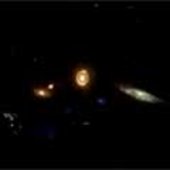Abell S1077
Bright arcs are smeared around the heart of galaxy cluster Abell S1077
in this image taken by the NASA/ESA Hubble space telescope. The arcs are
stretched images of distant galaxies distorted by the cluster’s
enormous gravitational field.
Galaxy clusters are large groupings of galaxies, each hosting millions
of stars. They are the largest existing structures in the Universe,
bound by the gravitational attraction between them.
The amount of matter condensed in such groupings is so high that their
gravity is enough to warp even the fabric of space-time, distorting the
path that light takes when it travels through the cluster.
In some cases, this phenomenon produces an effect somewhat like a
magnifying lens, allowing us to see objects that are aligned behind the
cluster and that would otherwise be undetectable from Earth.
In this image, stretched stripes that look like scratches on a lens are
in fact galaxies whose light is heavily distorted by the gravitational
field of the cluster.
Astronomers use the effects of gravitational lensing to peer far back in
time and space to see the furthest objects located in the early
Universe.
One of the record holders is galaxy MACS0647-JD, whose light was
magnified by galaxy cluster MACS J0647+7015 and has been travelling for
13.3 billion years to reach Earth.
RELATED ARTICLES:


Planck spots hot gas bridging galaxy cluster pair20 November 2012
ESA’s Planck space telescope has made the first conclusive detection of a
bridge of hot gas connecting a pair of galaxy clusters across 10
million light-years of intergalactic space.
Guillermo Gonzalo Sanchez Achutegui
ayabaca@gmail.com
ayabaca@hotmail.com
ayabaca@yahoo.co
Inscríbete en el Foro del blog y participa : A Vuelo De Un Quinde - El Foro!




No hay comentarios:
Publicar un comentario